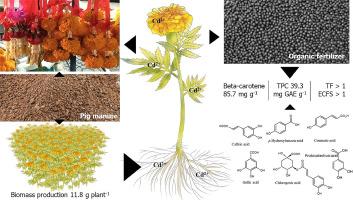在温室和田间条件下利用万寿菊对镉进行植物管理
IF 5.4
Q2 ENGINEERING, ENVIRONMENTAL
引用次数: 0
摘要
温室和田间研究调查了亚洲流行的观赏花卉万寿菊(Tagetes erecta L.)对土壤镉(Cd)的植物萃取潜力。研究还考察了有机肥、牛粪和猪粪在支持植物生长和提高镉吸收方面的效果。在补充了猪粪的土壤中生长的植物产生的生物量最大(温室和田间试验中分别为 12.8 ± 1.6 和 11.8 ± 0.9 g plant-1)。在所有处理中,植物各部分积累镉的顺序为:芽>;根>;花。此外,直立金盏花具有很高的植物萃取潜力,这一点可以从嫩枝的转运因子和富集系数 > 1 中得到证明。在添加了有机肥(CdOrg)的镉污染土壤中栽培的万寿菊,花朵中的镉浓度低于最高允许食用水平(0.2 毫克/千克),这表明食用花朵不会对人体健康造成危害。此外,花朵中还含有大量的总酚类化合物和酚酸,这可能表明它们具有作为镉引发的氧化应激指标的潜力。此外,酚类化合物还可以作为抗氧化剂和抗菌剂,从而成为医药制成品的前体。施用有机肥和某些有机添加剂可能有助于提高酚类物质的浓度。单用镉处理导致生物活性化合物产量和抗氧化能力最低。建议将直立萝蔔作为观赏物种用于镉的植物萃取,同时提高当地经济效益,还可用于植物萃取,以获得生物活性化合物和抗氧化能力。本文章由计算机程序翻译,如有差异,请以英文原文为准。

Phytomanagement of cadmium using Tagetes erecta in greenhouse and field conditions
Greenhouse and field studies investigated the phytoextraction potential of soil cadmium (Cd) by Tagetes erecta L., a popular ornamental flower in Asia. The effects of organic fertilizer, cattle manure, and pig manure in supporting plant growth and enhancing Cd uptake were also examined. Plants grown in soil supplemented with pig manure produced greatest biomass (12.8 ± 1.6 and 11.8 ± 0.9 g plant−1 in greenhouse and field experiments, respectively). Plant parts accumulated Cd in the order: shoot > root > flower in all treatments. Furthermore, T. erecta had a high phytoextraction potential as evidenced by translocation factors and enrichment coefficients > 1 for shoots. Marigolds cultivated in Cd-contaminated soil supplemented with organic fertilizer (CdOrg) exhibited Cd concentrations in flowers below the Maximum Permissible Level for consumption (< 0.2 mg kg−1), indicating that the edible flowers pose no health risk to humans. The flowers additionally contained significant quantities of total phenolics and phenolic acids, which may indicate their potential as an indicator of Cd-initiated oxidative stress. The phenolic compounds can furthermore function as precursors for manufactured medicinal products by acting as antioxidants and antimicrobials. Application of organic fertilizer and selected organic amendments may have contributed to the greater concentrations of phenolics. The Cd alone treatment resulted in lowest production of bioactive compounds and antioxidant capacity. It is proposed that T. erecta be applied for Cd phytoextraction while enhancing local economies as an ornamental species, and for plant extracts for application of bioactive compounds and antioxidant capacity.
求助全文
通过发布文献求助,成功后即可免费获取论文全文。
去求助
来源期刊

Journal of hazardous materials advances
Environmental Engineering
CiteScore
4.80
自引率
0.00%
发文量
0
审稿时长
50 days
 求助内容:
求助内容: 应助结果提醒方式:
应助结果提醒方式:


